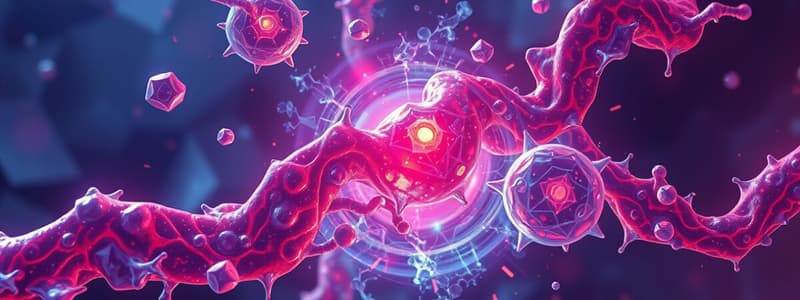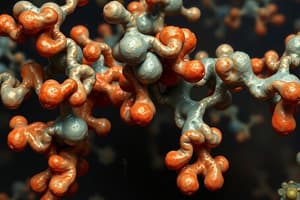Podcast
Questions and Answers
What factors affect enzyme function?
What factors affect enzyme function?
Enzyme concentration, substrate concentration, temperature, pH, salinity, activators, inhibitors, allosteric regulation, metabolic pathways, and efficiency.
How does enzyme concentration affect enzyme function?
How does enzyme concentration affect enzyme function?
As enzyme concentration increases, reaction rate increases, but the substrate can become a limiting factor.
How does substrate concentration affect enzyme function?
How does substrate concentration affect enzyme function?
As substrate concentration increases, reaction rate increases until all enzymes have their active sites engaged.
How does heat affect enzyme function?
How does heat affect enzyme function?
How does the cold affect enzyme function?
How does the cold affect enzyme function?
What are endotherms?
What are endotherms?
What are ectotherms?
What are ectotherms?
How do changes in pH affect enzyme function?
How do changes in pH affect enzyme function?
What pH do most human enzymes prefer?
What pH do most human enzymes prefer?
What pH does pepsin prefer?
What pH does pepsin prefer?
What pH does trypsin prefer?
What pH does trypsin prefer?
What is salinity?
What is salinity?
How do changes in salinity affect enzyme function?
How do changes in salinity affect enzyme function?
Why is the Dead Sea called dead?
Why is the Dead Sea called dead?
What are activators?
What are activators?
What are cofactors?
What are cofactors?
What are coenzymes?
What are coenzymes?
What are examples of vitamins that act as activators?
What are examples of vitamins that act as activators?
What are inhibitors?
What are inhibitors?
What are competitive inhibitors?
What are competitive inhibitors?
What are some examples of competitive inhibitors?
What are some examples of competitive inhibitors?
What does penicillin do?
What does penicillin do?
What does disulfiram do?
What does disulfiram do?
How can competitive inhibitors be overcome?
How can competitive inhibitors be overcome?
What is a noncompetitive inhibitor?
What is a noncompetitive inhibitor?
What are examples of noncompetitive inhibitors?
What are examples of noncompetitive inhibitors?
What does an allosteric inhibitor do?
What does an allosteric inhibitor do?
What do some anticancer drugs do?
What do some anticancer drugs do?
What does cyanide poisoning do?
What does cyanide poisoning do?
What is irreversible inhibition?
What is irreversible inhibition?
What are two types of irreversible inhibitors?
What are two types of irreversible inhibitors?
What does a competitive irreversible inhibitor do?
What does a competitive irreversible inhibitor do?
What does an allosteric irreversible inhibitor do?
What does an allosteric irreversible inhibitor do?
What are examples of allosteric irreversible inhibitors?
What are examples of allosteric irreversible inhibitors?
What is a cholinesterase inhibitor?
What is a cholinesterase inhibitor?
What is feedback inhibition?
What is feedback inhibition?
What is allosteric regulation?
What is allosteric regulation?
What are metabolic pathways?
What are metabolic pathways?
How does efficiency relate to factors that affect enzyme function?
How does efficiency relate to factors that affect enzyme function?
Flashcards are hidden until you start studying
Study Notes
Factors Affecting Enzyme Function
- Key factors include enzyme concentration, substrate concentration, temperature, pH, salinity, activators, inhibitors, allosteric regulation, metabolic pathways, and overall efficiency.
Enzyme Concentration
- Increasing enzyme concentration enhances the reaction rate until substrate becomes limiting, leading to saturation where not all enzyme active sites can bind to substrates.
Substrate Concentration
- Higher substrate concentration accelerates the reaction rate, but it levels off once all enzymes are saturated, meaning every active site is occupied.
Temperature Effects
- Elevated temperature increases molecular energy, which can disrupt weak bonds, potentially causing denaturation and loss of the enzyme's 3D structure.
Cold Temperature Effects
- Cold temperatures reduce molecular movement, leading to fewer collisions between enzymes and substrates, thus slowing reaction rates.
Endotherms and Ectotherms
- Endotherms are warm-blooded animals that thrive at above-average temperatures; ectotherms are cold-blooded animals that prefer lower temperatures.
pH Influence
- Changes in pH introduce or remove hydrogen ions, disrupting bonds and 3D shapes, potentially leading to denaturation of proteins. Most human enzymes prefer a pH of 6-8.
- Pepsin, an enzyme in the stomach, functions optimally at a pH of 2-3, while trypsin, found in the small intestine, prefers pH 8.
Salinity
- Salinity refers to salt concentration, which affects enzyme function similarly to pH by adding or removing ions, disrupting bonds, and impacting enzyme shape.
Enzyme Activity and the Dead Sea
- Extreme salinity in the Dead Sea hinders enzyme functionality, rendering it "dead" in terms of biological activity.
Activators and Cofactors
- Activators support enzyme activity and include cofactors (small, inorganic compounds like Mg, K, Ca) and coenzymes (organic molecules like NAD and FAD) that bind near the active site.
Inhibitors
- Inhibitors are molecules that reduce enzyme activity, classified into competitive and noncompetitive inhibitors, and play a role in allosteric regulation.
Competitive Inhibition
- Competitive inhibitors compete with substrates for the active site. Examples include penicillin, which inhibits bacterial cell wall formation, and disulfiram, which disrupts alcohol breakdown.
Overcoming Competitive Inhibition
- Increasing substrate concentration can outcompete competitive inhibitors, thus maintaining enzyme activity.
Noncompetitive Inhibition
- Noncompetitive inhibitors bind to an alternative site, altering enzyme shape and function without competing for the active site. Examples include certain anticancer drugs and cyanide.
Irreversible Inhibition
- Irreversible inhibitors permanently bind to enzymes, which can occur through competitive or allosteric means, leading to permanent loss of enzyme function.
Allosteric Inhibition
- Allosteric inhibitors bind to sites other than the active site, causing conformational changes that render the active site nonfunctional.
Feedback Inhibition
- Feedback inhibition is a regulatory mechanism where the end product of a metabolic pathway inhibits an earlier enzyme to prevent overproduction, maintaining efficiency.
Allosteric Regulation
- Involves conformational changes in enzymes induced by regulatory molecules. Activators ensure enzymes remain in active forms.
Metabolic Pathways
- Chemical reactions of life are organized in pathways to enhance efficiency, allowing control over sequential reactions and preventing unnecessary accumulation of products.
Studying That Suits You
Use AI to generate personalized quizzes and flashcards to suit your learning preferences.




